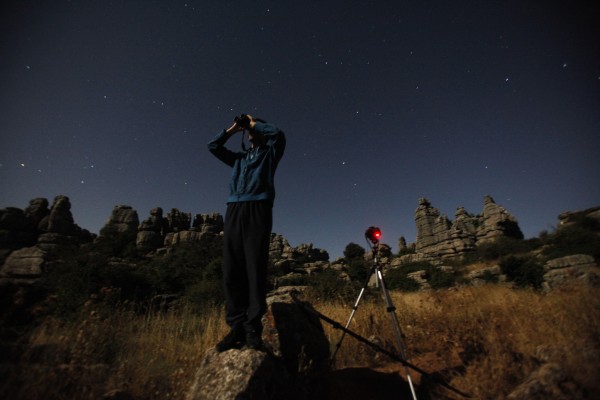August Sky to Show off Perseids Meteor Shower, Supermoon
| Kizha T. Trovillas | | Aug 07, 2014 03:47 PM EDT |
(Photo : Reuters) A man with binoculars observes the moon during the Perseid meteor shower in the southern Spanish town of Antequera, near Malaga early August 13, 2011.
A magnificent display in the sky will take place August 10 at the peak of an all-time favorite meteor shower joined with the biggest supermoon of the year.
The Perseids meteor shower, dubbed as one of the best meteor showers that can be observed by both astronomers and stargazers, will fill the night sky with as many as 100 shooting stars per hour, NASA said.
Like Us on Facebook
Between the months of July and August every year, Earth passes through the debris zone of Comet Swift Tuttle. The zone is a trail of dust and grit left behind by the Swift Tuttle's visit in the solar system.
When this debris hits the Earth's atmosphere at 140,000 mph, its specks disintegrate into flashes of light, which are commonly known as meteors.
The meteors are named Perseids because they radiate from the constellation Perseus. They can be spotted all over the sky but they will be clearly observed across the northern hemisphere, the space agency said.
On the same night, just as the Perseids meteor shower is set to peak, the moon will also become brighter.
The Supermoon will hit on Sunday. During this time, the moon can appear 14 percent larger and 30 percent brighter than a normal moon.
According to science blog EarthSky, the term "supermoon" originated 30 years ago from Richard Nolle. Nolle described a Supermoon as a new or full moon which happens when the moon is at or near its closest approach to Earth.
Although it is a bad news that the moon's glare may erase the black backdrop needed to see faint meteors, Perseids will still be bright enough to retain its own mark in the sky, NASA officer Bill Cooke said.
Furthermore, the next Supermoon is predicted to appear on Sept. 9 while Orionids, another meteor display, will start on October 2 until November 7 this year.
TagsNASA, Perseids, Perseids meteor shower, supermoon, Persues
©2015 Chinatopix All rights reserved. Do not reproduce without permission
EDITOR'S PICKS
-

Did the Trump administration just announce plans for a trade war with ‘hostile’ China and Russia?
-

US Senate passes Taiwan travel bill slammed by China
-

As Yan Sihong’s family grieves, here are other Chinese students who went missing abroad. Some have never been found
-

Beijing blasts Western critics who ‘smear China’ with the term sharp power
-

China Envoy Seeks to Defuse Tensions With U.S. as a Trade War Brews
-

Singapore's Deputy PM Provides Bitcoin Vote of Confidence Amid China's Blanket Bans
-

China warns investors over risks in overseas virtual currency trading
-

Chinese government most trustworthy: survey
-

Kashima Antlers On Course For Back-To-Back Titles
MOST POPULAR
LATEST NEWS
Zhou Yongkang: China's Former Security Chief Sentenced to Life in Prison

China's former Chief of the Ministry of Public Security, Zhou Yongkang, has been given a life sentence after he was found guilty of abusing his office, bribery and deliberately ... Full Article
TRENDING STORY

China Pork Prices Expected to Stabilize As The Supplies Recover

Elephone P9000 Smartphone is now on Sale on Amazon India

There's a Big Chance Cliffhangers Won't Still Be Resolved When Grey's Anatomy Season 13 Returns

Supreme Court Ruled on Samsung vs Apple Dispute for Patent Infringement

Microsoft Surface Pro 5 Rumors and Release Date: What is the Latest?











